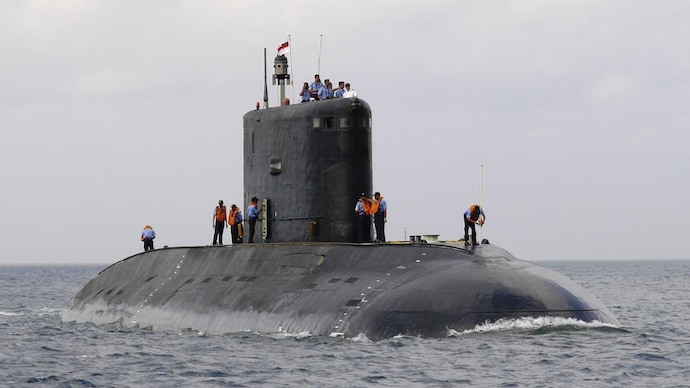Idrw Team
SOURCE: IDRW.ORG


In a significant step towards enhancing India’s naval capabilities, the Defence Research and Development Organisation (DRDO) has formally requested the Indian Navy to transfer one of its aging Kilo-class submarines. This move aims to utilize the vessel as a testbed for new technologies under the ambitious Project-76, which plans to introduce a next-generation class of submarines.
Project-76 is envisioned as a leap forward in India’s indigenous submarine manufacturing, focusing on creating advanced, air-independent propulsion (AIP)-equipped diesel-electric attack submarines. The project represents India’s commitment to reducing dependence on foreign technology while bolstering its maritime defense infrastructure.
Continue readingSOURCE: IDRW.ORG


Recent media reports suggesting that India is actively opposing Bangladesh’s prospective acquisition of JF-17 “Thunder” fighter jets have been contradicted by statements from the Indian Air Force (IAF). According to an IAF official speaking to idrw.org, the Indian government harbors no objections to this deal, refuting earlier narratives that portrayed India as vehemently against the procurement due to the aircraft’s origin from Pakistan and China, nations considered as adversaries by New Delhi.
Bangladesh has expressed interest in upgrading its air force capabilities, which currently rely on an aging fleet of F-7 and MiG-29 fighters. The JF-17, developed jointly by Pakistan and China, offers a modern alternative with its multi-role capabilities, which include air-to-air and air-to-ground missions. The interest was visibly demonstrated during a January visit by a high-ranking Bangladeshi military delegation, led by Lt. Gen. SM Qamarul Hassan, to Pakistan, where they showed keen interest in the JF-17 among other advanced defense systems.
Continue readingSOURCE: IDRW.ORG


The United Aircraft Corporation (UAC) has announced that the development of the Sukhoi Su-75 “Checkmate” is approaching its final stages, setting the stage for its introduction into the international arms market. This revelation comes from Sergei Korotkov, a senior official at UAC, who emphasized the aircraft’s status as a fifth-generation, single-engine stealth fighter jet, according to Russia’s TASS news agency.
The Su-75 “Checkmate” is designed to be a cost-effective yet advanced combat aircraft, aiming to compete with other fifth-generation fighters like the F-35 Lightning II from the U.S. and China’s Shenyang FC-31.
Continue readingSOURCE: IDRW.ORG


In a significant stride for India’s defense innovation and export capabilities, Big Bang Boom Solutions Pvt. Ltd., a winner of the Innovations for Defence Excellence (iDEX) initiative, has successfully exported the first unit of its groundbreaking Vajra Super Shot to the Kenyan Ministry of Defence. This achievement, facilitated by the Department of Defence Production (DefProdnIndia), underscores the growing impact of the ‘Make in India’ initiative in global defense innovation.
The Vajra Super Shot is a cutting-edge counter-drone system designed to address emerging threats posed by unmanned aerial vehicles (UAVs).
Continue readingSOURCE: IDRW.ORG

The Official United States Air Force Website has announced the cancellation of the much-anticipated F-35 and F-16 demonstrations scheduled for the Aero India 2025 to be held in Bengaluru from February 10th to 14th, 2025.
This decision marks a notable change to the lineup of the event, which is one of the largest aerospace exhibitions in Asia, showcasing the latest in military and civilian aviation technology. The cancellation comes as a surprise, given the historical presence of U.S. Air Force (USAF) aircraft at such international platforms to demonstrate their capabilities and foster military cooperation.
Continue readingSOURCE: IDRW.ORG


The first image of the Kiran UAV, repurposed under the Combat Air Teaming System (CATS) Optionally Manned Combat Aircraft (OMCA) program, has captured the attention of defense enthusiasts and professionals alike, going viral on X. This striking image showcases the aircraft in a unique two-tone blue scheme, hinting at its transformation from a venerable trainer to a cutting-edge unmanned aerial vehicle.
The aircraft in question, initially manufactured in 1985 by Hindustan Aeronautics Limited (HAL), is now nearly 40 years old. Originally designed as the HAL HJT-16 Kiran Mk.2 trainer, this jet has been reimagined for modern warfare.
Continue readingSOURCE: IDRW.ORG


The ambitious Project 75I (P-75I) of the Indian Navy, aimed at procuring six advanced diesel-electric submarines, has seen a dramatic escalation in costs. Initially projected in 2022 to be around ?40,000 crore ($4.89 billion), recent reports now estimate the total expenditure for the project to have soared to an astonishing ?70,000 crore ($8.55 billion).
This significant increase in the budget for the P-75I program, which seeks to enhance India’s underwater capabilities with submarines featuring air-independent propulsion (AIP) systems, has raised eyebrows and sparked debates on the fiscal management of defense projects. The project, which has been long in the making, is crucial for the Indian Navy to replenish its aging submarine fleet and to counterbalance regional naval challenges.
Continue readingSOURCE: IDRW.ORG


Adani Defence has recently provided a sneak peek into the Defence Research and Development Organisation’s (DRDO) latest innovation, the ULM-ER (UAV Launched Missile – Extended Range), an advanced variant of the existing UAV Launched Precision Guided Missile (ULPGM). This new missile system is designed to significantly extend the operational reach of unmanned aerial vehicles (UAVs) in combat scenarios.
The ULM-ER is anticipated to boast an impressive range of over 10 kilometers, a substantial upgrade from its predecessor’s capabilities. This extended range allows for greater standoff distances, thereby enhancing the safety of the launching UAV and providing a strategic advantage in target engagement.
Continue readingSOURCE: IDRW.ORG


The skies over Bengaluru have witnessed the second flight of the Tejas Mk1A, with keen observers spotting the fighter jet bearing the number ’34’ on its landing gear doors, strongly suggesting this is LA-5034, the second aircraft in the Mk1A series. This milestone marks another step forward in the Indian Air Force’s (IAF) modernization efforts, showcasing the prowess of India’s indigenous aircraft manufacturing capabilities.
Hindustan Aeronautics Limited (HAL), the manufacturer, has been pushing forward with production, and there’s an anticipation that the first two Tejas Mk1A jets will be handed over to the IAF by March 2025. This development follows closely on the heels of the first Tejas Mk1A’s successful maiden flight, with HAL confirming their commitment to meet the delivery schedules set by the IAF.
Continue readingSOURCE: IDRW.ORG


The commissioning of INS Surat, India’s first AI-enabled warship, marks a significant milestone in the Indian Navy’s modernization journey. This cutting-edge stealth destroyer is designed to bolster India’s maritime security by integrating advanced artificial intelligence capabilities, providing the vessel with enhanced operational efficiency, situational awareness, and decision-making abilities.
INS Surat, part of the Project 15B Visakhapatnam-class stealth destroyers, stands out for its integration of AI systems capable of Predictive Maintenance where AI system monitors the health of critical machinery and systems, predicting potential failures before they occur. This capability reduces downtime and ensures the ship remains mission-ready.
Continue readingSOURCE: IDRW.ORG


India is set to secure another major defense export deal, with Indonesia’s defense ministry expressing its intent to acquire the BrahMos supersonic cruise missile system. According to sources familiar with the matter, a letter has been sent by Indonesia’s defense ministry to the Indian embassy in Jakarta, outlining their interest in a deal worth approximately $450 million. This deal represents a significant milestone not only due to its scale but also because it includes a Transfer of Technology (ToT) provision, marking a first for the BrahMos missile system.
Indonesia’s commitment to purchasing the BrahMos missile system reinforces the growing demand for the world-renowned supersonic cruise missile. With a range of over 290 km, BrahMos is one of the fastest cruise missiles globally and has proven its capabilities in multiple defense systems, including surface-to-surface, air-to-surface, and even submarine-launched configurations.
Continue readingSOURCE: IDRW.ORG


The Advanced Light Helicopter (ALH) Dhruv MKIII, despite not making an appearance in the Republic Day Parade this year, is poised for a significant showcase at Aero India 2025. The helicopter, developed by Hindustan Aeronautics Limited (HAL), will feature both in flying displays and static exhibitions at the event scheduled for February 10-14 in Bengaluru.
The decision to exclude the ALH-Dhruv MKIII from the Republic Day parade stems from recent safety concerns following a series of accidents involving the helicopter. This has led to a cautious approach by the Indian military, ensuring that only thoroughly vetted platforms participate in high-profile public events.
Continue readingSOURCE: IDRW.ORG


At the highly anticipated Aero India 2025, Jayem Engine, in collaboration with Park Controls and Communication Private Limited, is set to showcase a groundbreaking addition to unmanned aerial vehicle (UAV) technology. The company will present its Jayem Aero Engine, specifically designed for the Rustom II Medium-Altitude Long-Endurance (MALE) UAV, marking a significant advancement in India’s indigenous defense capabilities.
The Jayem Aero Engine is a 2.2-liter turbocharged diesel engine, characterized by its inline arrangement and internal combustion mechanism. This engine has been meticulously engineered to meet the stringent demands of high-altitude, long-endurance missions crucial for surveillance, reconnaissance, and intelligence gathering.
Continue readingSOURCE: IDRW.ORG


The Defence Research and Development Organisation (DRDO) has initiated an ambitious project to develop advanced Military Internet of Things (MIoT) applications utilizing Edge/Edge Server/Central Server-based architectures. This project is a critical step toward integrating modern data analytics and artificial intelligence (AI) into military operations, enabling real-time decision-making and efficient resource management in military environments.
The proposed solution will incorporate a robust mechanism to capture, process, and manage data from various sensors deployed in the field. The system will process this data at the IoT node level before transmitting it to a central control center or a smart military base for further analysis and storage in a centralized database.
Continue readingSOURCE: IDRW.ORG


China’s recent confirmation of the development of a hypersonic air-to-air missile (HAAM) marks a significant advancement in its defense capabilities and presents a notable challenge to India’s air defense and air superiority strategies. Announced on January 19, 2025, through the South China Morning Post, this missile is designed to operate at speeds exceeding Mach 5, equipped to target high-value assets like Airborne Warning and Control Systems (AWACS) and other strategic aircraft that are often stationed far from conflict zones.
The missile, capable of flying at speeds greater than Mach 5, leverages the advantage of speed and unpredictability, making it extremely challenging to intercept with current air defense systems.The use of arc-heated wind tunnels for testing signifies China’s focus on overcoming the severe aerodynamic heating issues associated with hypersonic travel. Temperatures experienced at such velocities can degrade missile structures or disrupt electronics, but successful management of these conditions suggests a robust, combat-ready missile.
Continue reading